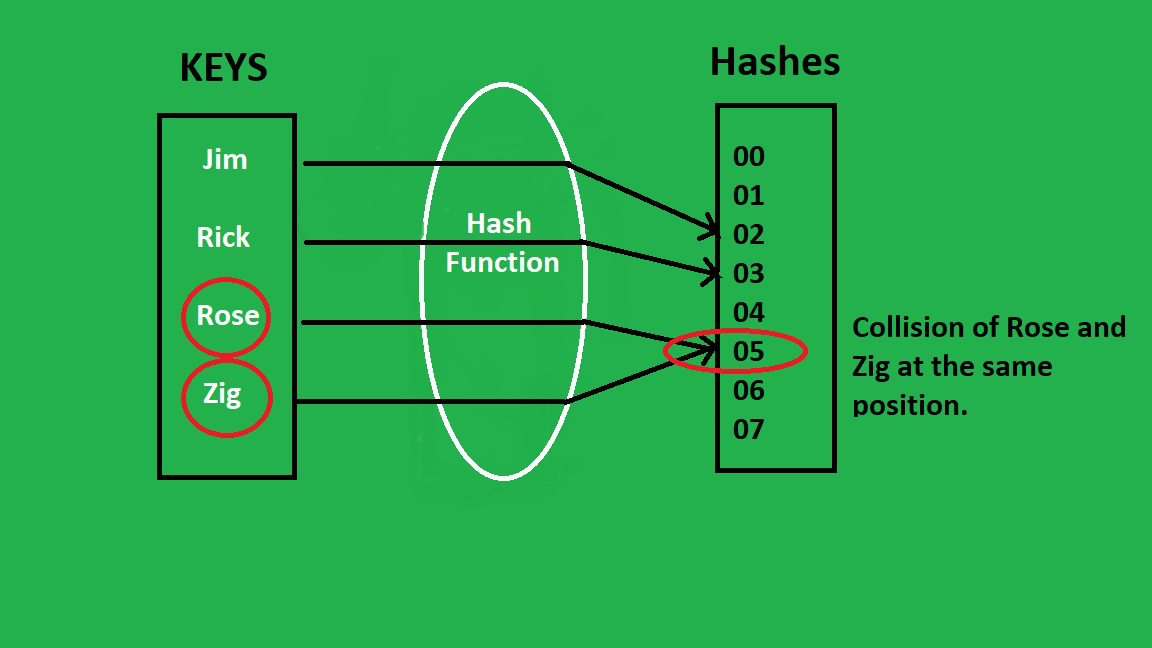用双向链表实现哈希表链的Java程序
哈希表(类似于一般的表)提供了动态集合操作的一个子集。通常,一组键根据某些关系映射到某些值。但是,可能会出现不同的键映射到哈希函数提供的相同位置的情况,从而导致冲突。

克服这种情况的方法之一是哈希表链接。
解决冲突的链接方法通过继续并将映射到该插槽中的插槽的所有键但将它们表示为链表来处理它。
Java中的哈希表链可以同时使用单链表和双链表。虽然实现是一样的,唯一的区别是双向链表允许双向遍历,即节点包含一个指向下一个和前一个节点的指针。因此,与单链表 (O(n)) 相比,在已知位置插入和删除的复杂度降低到 O(1)。
例子 :
In Singly Linked List : g -> e -> e -> k -> s
Here, each node contains a pointer to the next node only.
In Doubly Linked List : g <-> e <-> e <-> k <-> s
Each node contains pointer to the next as well as previous node.方法 :
- 插入:要插入,只需对键进行散列以获取表中的位置(必须插入此新键的列表),然后使用标准链表过程将键插入双向链表的头部(代码中给出)。
- 删除:只需通过哈希函数遍历键映射到的列表,并使用标准链表过程(在代码中给出)从该列表中删除键。
下面是上述方法的实现:
Java
// Java implementation of Hashtable chaining
// using doubly linked list
import java.util.*;
class DoublyLinkedListNode {
// Declaration of Nodes
DoublyLinkedListNode next, prev;
int data;
// constructor
DoublyLinkedListNode(int data)
{
this.data = data;
next = null;
prev = null;
}
}
class HashTableChainingDoublyLinkedList {
// Declaration of Hash Table
DoublyLinkedListNode[] hashTable;
// stores the size of HashTable
int size;
// Constructor
HashTableChainingDoublyLinkedList(int hashTableSize)
{
// Creating an empty Hash Table
hashTable = new DoublyLinkedListNode[hashTableSize];
size = 0;
}
// Function to check if hash table is empty
public boolean isEmpty() { return size == 0; }
// Function to clear/delete all elements from Hash table
public void clear()
{
// Capacity of Hash Table
int len = hashTable.length;
// Creating new empty Hash Table
// of same initial capacity
hashTable = new DoublyLinkedListNode[len];
size = 0;
}
// Function that returns size of Hash Table
public int getSize() { return size; }
// Function to insert a value/element
public void insert(int value)
{
size++;
// gets the position/index where the value should be
// stored
int position = hash(value);
// creates a node for storing value
DoublyLinkedListNode node
= new DoublyLinkedListNode(value);
DoublyLinkedListNode start = hashTable[position];
if (hashTable[position] == null)
hashTable[position] = node;
else {
node.next = start;
start.prev = node;
hashTable[position] = node;
}
}
// Function to remove an element
public void remove(int value)
{
try {
// gets the position where the value to
// be deleted exists
int position = hash(value);
DoublyLinkedListNode start
= hashTable[position];
DoublyLinkedListNode end = start;
// if value is found at start
if (start.data == value) {
size--;
if (start.next == null) {
// removing the value
hashTable[position] = null;
return;
}
start = start.next;
start.prev = null;
hashTable[position] = start;
return;
}
// traversing the list
// until the value is found
while (end.next != null
&& end.next.data != value)
end = end.next;
// if reached at the end without finding the
// value
if (end.next == null) {
System.out.println("\nElement not found\n");
return;
}
size--;
if (end.next.next == null) {
end.next = null;
return;
}
end.next.next.prev = end;
end.next = end.next.next;
hashTable[position] = start;
}
catch (Exception e) {
System.out.println("\nElement not found\n");
}
}
// Definition of Hash function
private int hash(Integer x)
{
int hashValue = x.hashCode();
hashValue %= hashTable.length;
if (hashValue < 0)
hashValue += hashTable.length;
return hashValue;
}
// Function to print hash table
public void printHashTable()
{
System.out.println();
for (int i = 0; i < hashTable.length; i++) {
System.out.print("At " + i + ": ");
DoublyLinkedListNode start = hashTable[i];
while (start != null) {
System.out.print(start.data + " ");
start = start.next;
}
System.out.println();
}
}
// Driver Code
public static void main(String[] args)
{
HashTableChainingDoublyLinkedList hashTab
= new HashTableChainingDoublyLinkedList(5);
hashTab.insert(99);
hashTab.insert(23);
hashTab.insert(36);
hashTab.insert(47);
hashTab.insert(80);
hashTab.printHashTable();
hashTab.insert(92);
hashTab.insert(49);
hashTab.printHashTable();
hashTab.remove(99);
hashTab.printHashTable();
hashTab.clear();
hashTab.printHashTable();
System.out.println(hashTab.isEmpty());
}
}输出
At 0: 80
At 1: 36
At 2: 47
At 3: 23
At 4: 99
At 0: 80
At 1: 36
At 2: 92 47
At 3: 23
At 4: 49 99
At 0: 80
At 1: 36
At 2: 92 47
At 3: 23
At 4: 49
At 0:
At 1:
At 2:
At 3:
At 4:
true